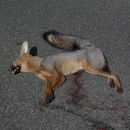pt-BR
nomes no trilho de navegação


Perception Channels: tactile ; chemical
More than 2,500 individuals are killed annually, which is approximately 16% of the population. This is taking a toll on the population. Protected cape fox populations are in the Soetdoring Nature Reserve (1.3/km2) and the Willem Pretorius Game Reserve (0.65/km2, south) and north (0.12/km2) (IUCN, 1998).
CITES: no special status
IUCN Red List of Threatened Species: least concern
These foxes are presumed to prey on livestock, in particular lambs. Farmers have permission to remove animals causing damage to livestock. Numbers have been abundant in the past but appear to be in decline since 1985 because of this (IUCN, 1998).
Negative Impacts: crop pest
Pelts are used in fur blankets (IUCN 1998).
Positive Impacts: body parts are source of valuable material
Cape foxes are sympatric with the aardwolf (Proteles cristata), the black-backed jackal (Canis meomelas), and the bat-eared fox (Octocyon megalotis) and therefore may limit their populations through competition. However, there is enough separation in activity times, space, and diet to allow for their coexistence (Bothma, 1984).
V. chama probably helps to regulate populations of small mammals through its predatory behavior, which in turn probably has an effect on the plant communities upon which such small mammals feed.
V. chama is known to cache food. The diet of this species consists mainly of small rodents, rabbits, insects and beetle larvae, and small reptiles. V. chama also scavenges, and has been known to take livestock, which tends to get them into trouble with humans (Nel, 1984). The different distances between canine teeth, measured from bite marks, between the cape fox (15mm) and the black-backed jackal (Canis mesomelas) are used in determining which species is responsible for killing livestock (IUCN, 1998).
Animal Foods: mammals; reptiles; carrion ; insects
Foraging Behavior: stores or caches food
Primary Diet: carnivore (Eats terrestrial vertebrates)
Cape foxes (Vulpes chama) are found in sub-Saharan African desert. The species ranges from the southern tip of South Africa and Cape Province, north through Namibia, Botswana, Transvaal, Natal and into the Albany district. This is the only species of Vulpes in Africa that is known to range below the equator (IUCN, 1998).
Biogeographic Regions: ethiopian (Native )
V. chama prefers open habitat such as arid savannas as well as semi-desert scrub, and avoids forests (IUCN, 1998).
Habitat Regions: temperate ; tropical ; terrestrial
Terrestrial Biomes: scrub forest
Lifespan has not been reported for this species
Average lifespan
Status: wild: 10.0 years.
V. chama is a small fox. Head and body length is 55 cm and height at shoulder is 36 cm. Males weigh about 2.6 kg and females are approximately 5% smaller than this. The pelage is gray-silver, with reddish head and forelimbs. There are white cheek patches, and black patches on the hind limbs. The ventral parts are whitish. V. chama has a bushy tail measuring about 34.4 cm, almost half the length of the head and body. (IUCN, 1998).
Average mass: 2.6 kg.
Average length: 55 cm.
Other Physical Features: endothermic ; bilateral symmetry
Average mass: 4000 g.
Predation upon this species has not been documented. It is likely that large birds of prey and larger carnivores may take these foxes, especially the young. No anti-predator adaptations or behaviors have been noted in the literature.
These animals breed monogamously. The male and female form pairs in the spring. Pups are born in early summer months.
Mating System: monogamous
V. chama forms pairs in southern hemisphere winter months of July and August. The gestation period is 51-52 days with three to five pups a litter. Canids have one litter per year, but in some dens of the cape fox multiple litters have been observed. Pups are usually born in late spring to early summer (September–November) but cape foxes are known to have litters as late as December.
The male provides for the female for the first and second week after birth and both parents care for the young at the beginning. It is not known how long the male stays with the family group (Nel, 1984). Pups start foraging at four months, and become independent at 5 months. Sexual maturity is reached by 9 months (IUCN,1998).
Breeding season: Pups are usually born in early summer.
Range number of offspring: 1 to 4.
Range gestation period: 51 to 52 days.
Average age at sexual or reproductive maturity (female): 9 months.
Average age at sexual or reproductive maturity (male): 9 months.
Key Reproductive Features: iteroparous ; seasonal breeding ; year-round breeding ; gonochoric/gonochoristic/dioecious (sexes separate); sexual ; fertilization (Internal ); viviparous
Average number of offspring: 4.
Average age at sexual or reproductive maturity (male)
Sex: male: 274 days.
Average age at sexual or reproductive maturity (female)
Sex: female: 274 days.
Both male and female care for the pups in the beginning, although the male may leave the family. Canids typically produce altricial young. Cape fox young stay near the den until they are able to follow the mother at about 4 months of age. They typically disperse around 5 months of age, and become sexually mature at 9 months of age.
Parental Investment: altricial ; male parental care ; female parental care